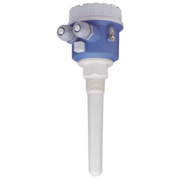Minicap FTC 260

Measurement principle The Minicap is an electronic switch. When the limit is exceeded or the load falls below the limit, a switching signal is output. A switch housing or signal output device (e.g. lights, horns, programmable logic controller, DCS, etc.) can be connected to the Minicap.
It has a switch for minimum/maximum failsafe selection. It detects the formation of deposits on the probe, and compensates for the effects of this so that the switching point is always accurately maintained. The effect of deposit compensation depends on the thickness of the coating on the probe, the conductivity of coating, and the sensitivity adjustment of the electronics.
The Minicap comes factory calibrated. Sensitivity adjustments can be made in the field. To ensure safe operation, the Minicap system must be properly grounded in a metal or reinforced concrete vessel. For vessels made of non–conducting material, the ground wire must be connected to an earth ground near the vessel. Commercially available installation cable can be used for the connections.
Features
- Calibration–free startup
- Active buildup compensation
- Maintenance free design
- Mechanically rugged
- No moving parts to wear
- Minimum/Maximum failsafe switch selection
- Sensitivity adjustment
- FM dust-ignition-proof approval
Application example
Min. 3.94” Level detection in vessels with bulk solids. The vessels can be made of various materials (e.g. metal, plastic, concrete), as these do not affect measurement. The filling stream should not be directed onto the probe.
Product: Bulk solids
- Probe length : Rod: 5.51”
- Process pressure : -14.5 to +362 psi
- Product temperature: -40 to +248 °F
- Grain size:Diameter ≥ 1.2”
FTC260 – Application
The Minicap FTC260 is suitable for level detection of powdery and fine–grain bulk solids, such as grain, flour, powdered milk, mixed feed, cement, chalk or gypsum. Also in dust explosive areas. The Minicap comes in two versions:
- Relay output (SPDT – single–pole double–throw) with AC or DC power
- PNP output with three–wire DC connection
